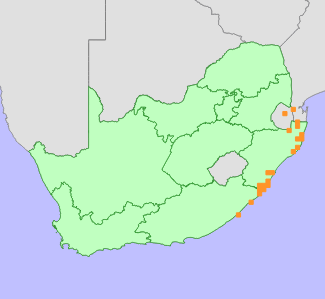|
Scientific Name | Bulbine asphodeloides (L.) Spreng. |
Higher Classification | Monocotyledons |
Family | ASPHODELACEAE |
Synonyms | Anthericum altissimum Mill., Anthericum asphodeloides L., Anthericum longiscapum Jacq., Anthericum succulentum Salisb., Bulbine altissima (Mill.) Fourc., Bulbine crocea L.Guthrie, Bulbine dielsii Poelln., Bulbine longiscapa (L.) Willd., Bulbine mettinghi Ten., Bulbine pallida Baker, Phalangium altissimum (Mill.) Kuntze, Phalangium asphodeloides Kuntze |
Common Names | Balsamkopieva (a), Copaiva (e), Geelkatstert (a), Ibhucu (z), Intelezi (x), Ithethe Elimpofu (z), Itswelemyoka (x), Khomo-ya-ntsuka (ss), Kopieva (a), Moetsa-mollo (ss), Pekane (ss), Sehlare Sa Mollo (ss), Sehlare Sa Pekana (ss), Snake Flower (e), Wilde Kapiefa (a), Wildekopieva (a) |
National Status |
Status and Criteria | Least Concern |
Assessment Date | 2018/09/30 |
Assessor(s) | L. von Staden |
Justification | Bulbine asphodeloides is a widespread species that is not in danger of extinction. |
Distribution |
Endemism | Not endemic to South Africa |
Provincial distribution | Eastern Cape, KwaZulu-Natal |
Range | This species is widespread and common along the Eastern Cape and KwaZulu-Natal coast, with scattered occurrences inland. It also occurs in Swaziland and Mozambique. |
Habitat and Ecology |
Major system | Terrestrial |
Major habitats | KwaZulu-Natal Coastal Belt Grassland, Pondoland-Ugu Sandstone Coastal Sourveld, KwaZulu-Natal Coastal Belt Thornveld, Subtropical Seashore Vegetation, Maputaland Coastal Belt, Maputaland Wooded Grassland, Western Maputaland Clay Bushveld, Transkei Coastal Belt, Subtropical Alluvial Vegetation, Subtropical Dune Thicket, Tembe Sandy Bushveld, Eastern Valley Bushveld, Western Maputaland Sandy Bushveld, Makatini Clay Thicket, Maputaland Pallid Sandy Bushveld, Muzi Palm Veld and Wooded Grassland, Granite Lowveld, Delagoa Lowveld, KwaZulu-Natal Sandstone Sourveld, Southern Lebombo Bushveld |
Description | It occurs on rocky hillsides in coastal grassland, also on sandy flats and roadsides, 0-500 m. |
Threats |
| About 40% of this species' habitat has been historically lost to urban expansion, coastal development and sugarcane plantations. Habitat loss and degradation continues. |
Population |
This species is somewhat resilient to disturbance, and is still common in spite of extensive habitat loss.
|
Population trend | Unknown |
Assessment History |
Taxon assessed |
Status and Criteria |
Citation/Red List version | | Bulbine asphodeloides (L.) Spreng. | Least Concern | Raimondo et al. (2009) | |
Bibliography |
Baijnath, H. 1977. Taxonomic studies in the genus Bulbine. Unpublished PhD, Reading University, Reading.
Kativu, S. 2001. Asphodelaceae. In: G.V. Pope (ed). Flora Zambesiaca 12 (Part 3):25-48. Royal Botanic Gardens, Kew.
Raimondo, D., von Staden, L., Foden, W., Victor, J.E., Helme, N.A., Turner, R.C., Kamundi, D.A. and Manyama, P.A. 2009. Red List of South African Plants. Strelitzia 25. South African National Biodiversity Institute, Pretoria.
|
Citation |
| von Staden, L. 2018. Bulbine asphodeloides (L.) Spreng. National Assessment: Red List of South African Plants version . Accessed on 2025/05/31 |
 Comment on this assessment
Comment on this assessment

